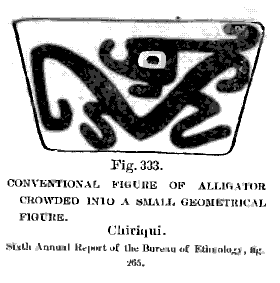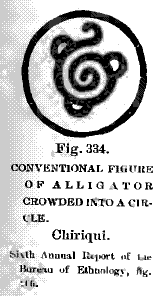

The Swastika
The Cross Among The American Indians

 A third illustration from the same
group of ware, given in fig. 259 [fig. 332 of the present paper] shows,
in some respects, a higher degree of convention. * * *
A third illustration from the same
group of ware, given in fig. 259 [fig. 332 of the present paper] shows,
in some respects, a higher degree of convention. * * * I shall now call attention to some important individualized or well-defined agencies of convention. First, and most potent, may be mentioned the enforced limits of the spaces to be decorated, which spaces take shape independently of the subject to be inserted. When the figures must occupy a narrow zone, they are elongated; when they must occupy a square, they are restricted longitudinally, and when they occupy a circle, they are necessity coiled up. Fig. 265 [fig. 333 of the present paper] illustrated the effect produced by crowding the oblong figure into a short rectangular space. The head is turned back over the body and the tail is thrown down along the side of the space. In fig. 266 [fig. 334 of the present paper] the figure occupies a circle and is, in consequence, closely coiled up, giving the effect of a serpent rather than an alligator. * * *
 I
present five series of figures designed to illustrate the stages through
which life forms pass in descending from the realistic to highly specialized
conventional shapes. In the first series (fig. 277) [fig. 335 of the present
paper] we begin with a, a meager but graphic sketch of the alligator;
the second figure, b, is hardly less characteristic, but is much
simplified; in the third, c, we have still three leading features
of the creature --- the body line, the spots, and the stroke at the back
of the head; and in the fourth, d, nothing remains but a compound
yoke-like curve, standing for the body of the creature, and a single dot.
I
present five series of figures designed to illustrate the stages through
which life forms pass in descending from the realistic to highly specialized
conventional shapes. In the first series (fig. 277) [fig. 335 of the present
paper] we begin with a, a meager but graphic sketch of the alligator;
the second figure, b, is hardly less characteristic, but is much
simplified; in the third, c, we have still three leading features
of the creature --- the body line, the spots, and the stroke at the back
of the head; and in the fourth, d, nothing remains but a compound
yoke-like curve, standing for the body of the creature, and a single dot.
The figures of the second series (fig. 278) [fig. 336 of the present paper] are nearly all painted upon low, round nodes placed about the body of the alligator vases, and hence are enclosed in circles. The animal figure in the first example is coiled up like a serpent [fig. 334], but still preserves some of the well-known characters of the alligator. In the second example 'fig. 336b] we have a double hook near the center of the space which takes the place of the body, but the dotted triangles are placed separately against the encircling line. In the next figure the body symbol is omitted and the three triangles remain to represent the animal. In the fourth there are four triangles, and the body device being restored in red takes the form of a cross. In the fifth two of the

We learn by the series of steps illustrated in the annexed cuts that the alligator radical, under peculiar restraints and influence, assumes conventional forms that merge imperceptibly into these classic devices.

Professor Holmes's theory of the evolution of the cross from the alligator and its location in Chiriqui is opposed to that of Professor Goodyear, who, in his "Grammar of the Lotus," ascribes the origin of the cross to the lotus and locates it in Egypt. I file what in law would be an "interpleader" --- I admit my want of knowledge of the subject under discussion, and leave the question to these gentlemen.
<< Previous Page Next Page >>
© 2004-2007 Northvegr.
Most of the material on this site is in the public domain. However, many people have worked very hard to bring these texts to you so if you do use the work, we would appreciate it if you could give credit to both the Northvegr site and to the individuals who worked to bring you these texts. A small number of texts are copyrighted and cannot be used without the author's permission. Any text that is copyrighted will have a clear notation of such on the main index page for that text. Inquiries can be sent to info@northvegr.org. Northvegr™ and the Northvegr symbol are trademarks and service marks of the Northvegr Foundation.

|